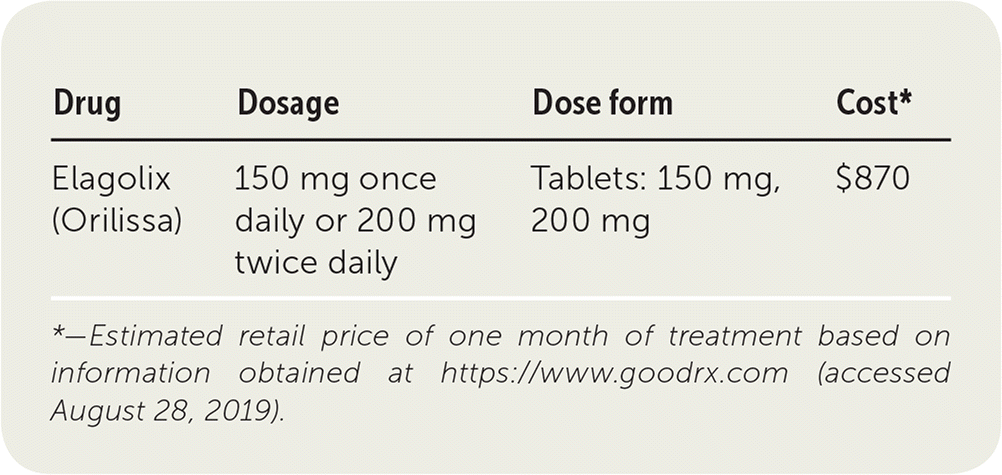
Am Fam Physician. 2019;100(8):502-504
Author disclosure: No relevant financial affiliations.
Elagolix (Orilissa) is an oral, nonpeptide, gonadotropin-releasing hormone (GnRH) antagonist used to treat moderate to severe pain related to endometriosis in reproductive-aged women.1 Inhibition of GnRH leads to estrogen suppression and subsequent dose-dependent inhibition of endometriotic proliferation.

| Drug | Dosage | Dose form | Cost* |
|---|---|---|---|
| Elagolix (Orilissa) | 150 mg once daily or 200 mg twice daily | Tablets: 150 mg, 200 mg | $870 |
Safety
Severe adverse effects of elagolix were uncommon during clinical trials.2,3 The most common reason for discontinuation of treatment was hot flashes or night sweats.3 As with other medications that induce low estrogen states, a reduction in bone density may occur in patients taking elagolix, although an increase in fracture risk has not been observed in studies to date. Elagolix should not be used in patients with known osteoporosis.1 Mood changes, depression, and suicidal ideation may occur and are more likely in patients with a history of depression. Asymptomatic elevations in alanine transaminase greater than three times the upper limit of normal will occur in 0.2% of patients treated with the standard dosage (150 mg once daily) and 1.1% of patients taking the higher dosage (200 mg twice daily).3 Elagolix affects liver enzyme metabolism of certain medications and is known to increase serum levels of digoxin and decrease serum levels of rosuvastatin (Crestor). Combining treatment with rifampin will increase serum levels of elagolix.1
Elagolix does not reliably inhibit ovulation, and its effect on menstrual bleeding may make pregnancy difficult to recognize. In addition, elagolix may decrease the effectiveness of combined oral contraceptives.1 It is recommended that women taking elagolix use nonhormonal contraception during treatment. Women should continue using nonhormonal contraception for one week after discontinuing use of elagolix.1 Women suspected of being pregnant should discontinue treatment. There is no information on excretion or presence of elagolix in human breast milk or its effect on milk production.
Tolerability
In clinical trials, the percentage of patients who dropped out because of adverse effects of elagolix was similar to that in the placebo group. About 25% of women will experience hot flashes or night sweats with the standard dosage, increasing to 46% with the higher dosage. Headache will be reported by 17% to 20% of women. Amenorrhea (4% to 7%) and insomnia (6% to 9%) may also occur.1 These effects have not been shown to abate over time.3
Effectiveness
Elagolix has been evaluated in two studies of 1,686 women with moderate to severe pain associated with endometriosis.3 A clinically important decrease in pain was defined as 0.81 points on a 4-point pain scale for menstrual pain and 0.36 points for nonmenstrual pain. By three months, about 46% of women taking the standard dosage of elagolix and 72% of those taking the higher dosage had a clinically important improvement in menstrual pain compared with 20% in the placebo group (number needed to treat = 4 with the standard dosage and 2 with the higher dosage). About one-half of women receiving either dosage will have a sustained reduction in nonmenstrual pain (number needed to treat = 7 with the standard dosage and 6 with the higher dosage). Only the higher dosage of elagolix is labeled to treat the pain of dyspareunia. A single trial compared elagolix with leuprolide (Lupron) in 174 patients, finding similar reductions in pain.4 Elagolix has not been directly compared with nonsteroidal anti-inflammatory drugs, progestin, or combined oral contraceptives.
Price
A 28-day supply of elagolix costs approximately $870. This is similar in price to a 28-day supply of leuprolide, which costs about $810. These medications are significantly more expensive than depot medroxyprogesterone (Depo-Provera), which costs approximately $40 for a three-month treatment regimen (one injection given every three months). In comparison, the average monthly cost of oral contraceptives is about $15.
Simplicity
The recommended dosage of elagolix is 150 mg taken orally once daily and should be started within seven days of the onset of menses. Women should use nonhormonal contraception while taking elagolix. Treatment with elagolix at the higher dosage of 200 mg twice daily is reserved for women with concomitant dyspareunia and endometriosis, and should be used for a shorter duration of therapy. Elagolix should be taken at the same time each day with or without food.1
Bottom Line
Elagolix can decrease pain in women with endometriosis, but it is expensive and has adverse effects similar to those of other medications that decrease estrogen levels. Elagolix should be reserved for women who do not benefit from nonsteroidal anti-inflammatory drugs or hormonal therapy.
The views expressed are those of the author and do not reflect the official policy or position of the Department of the Navy, the Department of Defense, or the U.S. government.
